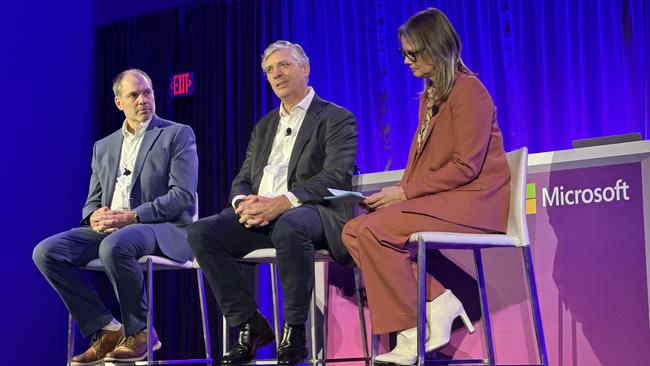The big problem for banks in an AI-powered world: who owns the customer?
As the world’s biggest tech companies offer new AI tools, Australian businesses are facing a dilemma: who owns the customer? Here’s how BOQ tackled it.

Australian businesses are facing a dilemma as they seek to expand their use of artificial intelligence-powered tools: who owns the customer?
The world’s three biggest cloud companies, Amazon, Microsoft and Google, have placed generative AI at the centre of their sales pitches to help lift productivity and woo corporate customers.
Meta is also investing heavily, incorporating AI across all its platforms, including Facebook, Instagram and WhatsApp, as founder and chief executive Mark Zuckerberg says it’s on track to become “the most-used AI assistant in the world” by the end of this year.
For businesses, the opportunities the technology presents are irresistible, given its promises to free employees to complete more value-added and less-productivity sapping tasks. For Bank of Queensland, AI also created problems when it was selecting which of the “hyperscalers” to partner with.
“Strategically, Amazon wants to own the customer. Google wants to own the customer,” BOQ chief technology officer Rob Wilson said. “Their advertising businesses and search businesses are all directed to how do we … take a piece of the financial services pie?
“So it just becomes another sort of another string to their bow, as it were. (Amazon) started with books … (and) now is doing basically everything.”
For banking, this creates issues, Mr Wilson said, particularly as the industry seeks to rebuild trust following the banking royal commission. Customers are increasingly concerned about how their data is managed.
“When they’re sort of pressing the button and saying, sure you can have this data, but then it’s up to us to be able to help those customers make sure that data is going to be safe, and that doesn’t lead to decisions which are going to have a negative impact on their lives,” Mr Wilson said.
“If you compare that to, let’s say, the hyperscalers and the Facebooks, who would you trust more – the bank, who is regulated to make sure that he doesn’t misuse the data, or the guys who are going to take your data and monetise it as quickly as possible, as broadly as possible. I think that trusted relationship is, how do we win those customers back to having direct relationships with the banks rather than … doing everything through a hyperscaler.”
It’s a similar problem carmakers face with software giants amid the $1.5 trillion fight for the last unconquered screen: the dashboard. Auto companies, which have had a patchy record of making their own infotainment operating systems, have partnered with Google, Apple and other tech titans to do the job for them.
That has prompted concern among some carmakers that they will miss out on a lucrative revenue stream for digital services.
Tesla chief executive Elon Musk said “technically we could sell for zero profit for now and then yield actually tremendous economics in the future through autonomy” and other subscription services, underscoring the scale of the opportunity.
But Polestar chief executive Thomas Ingenlath, who has partnered with Google, says “nobody bloody owns the customer”.
“We serve the customer and we serve the customer together with Google the best experience,” he said.

Still, BOQ has partnered with Microsoft because Mr Wilson says it does not have a direct customer channel. “They’re not like Amazon and Google, who are moving into the area of effectively trying to disintermediate that relationship with the customer. Microsoft is supporting us to have better relationships with our customers through their apps.”
Like NAB, which has built a “customer brain”, BOQ is seeking to use AI to make banking more personalised – something Mr Wilson said became “lost” during digitisation. “40 years ago when I was a young whipper snapper, the bank manager knew pretty much what his customers were doing. He knew what the family was doing, he knew who they were related to. He understood that and the context of who was making money and who wasn’t making money in the district.
“With digitisation in banking, we just lost that knowledge and that ability to bring that knowledge back into our decision-making. So for us, on the customer experience, it’s really about, how do you earn that right to have that trusted relationship with your customer, and how do you get to understand them at a level where you can add real value?
“You just don’t want to have someone telling ‘Oh, by the way, we’ve got this opportunity’.”
It seems ironic that a problem caused by tech can be solved by more tech but Mr Wilson said where AI was adding value was supporting human staff.
It can help bankers prepare for customer meetings by providing insights unique to a customer’s situation in a heartbeat. Using Copilot in this way has saved staff at least two hours a meeting.
“AI effectively is prepping those meetings, providing with all the context you need for those discussions and giving you effectively, if you like, that these are the five things you need to be talking about, and these are things we as an organisation are worried about.
“Small business is a good example, when you start seeing that business coming under pressure, being able to step in and say ‘Listen, do we need to help you with more working capital?’ It’s that ability to be proactive rather than reactive.”
BOQ’s use of AI has also sparked a 27 per cent lift in productivity across customer contact centre staff, while its risk analysis team can now perform analyses into one day instead of weeks.




To join the conversation, please log in. Don't have an account? Register
Join the conversation, you are commenting as Logout